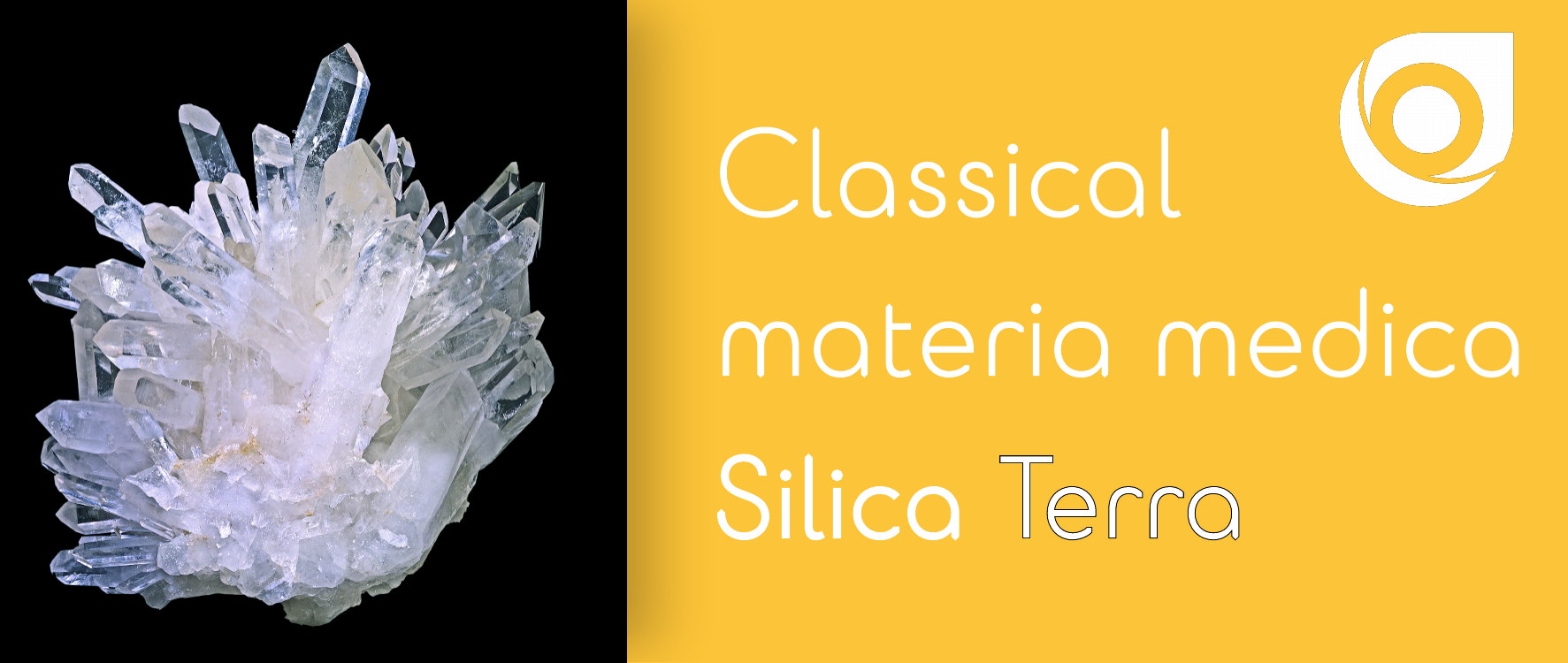The periodic table, a foundational tool of scientific knowledge, grants us insights into the elemental composition of our universe. Silica Terra, also known as Quartz, resides within the periodic table as a compound of silicon and oxygen. This mineral, with its diverse forms and transformative properties, invites us to explore its healing potential in the realm of homeopathy.

“A large proportion of the earth's crust is composed of silica. Sea sand (Silica Marina) is mainly composed of it. The spicules of many sponges are made up of silica. Silicates are taken up by plants and from them silica is often deposited on the surface or in the interior of their stems. Flint supplies the GRIT of the earth's crust, of plant life, and to a large extent of animal life also. Silicea is also a constituent of emeralds, aquamarines and other semi-precious stones, such as opal, zircon and amethyst. Compounds of silicon are of wide use in modern industries, e.g. computer chips, body implants, radio transmitters.”
Master F. Sandy Silicea. BJain Publishers, New Delhi, India.
Taxonomy, Natural Science, and Elemental Transformation in Silica Terra
Silica Terra belongs to the mineral kingdom, offering intriguing insights into its medicinal capabilities. Found abundantly in nature, Silica manifests in various forms, such as glass, flint, and even computer chips. Glass, a product of supercooled liquid silica, showcases its versatility and transformative qualities, from delicate stained glass windows to sturdy fibre optics.
Flint, a hard and dense form of silica, emphasizes its ability to endure intense pressures whilst simultaneously being easily fissured (hence its suitability in crafting Stone age tools and weapons). Computer chips, composed of intricate layers of silica, demonstrate Silica Terra's role in technological advancement and information storage. These diverse forms of Silica hint at the potential for healing within this homeopathic remedy.
Mythology and the Doctrine of Signatures of Silica Terra
Silica Terra's significance extends beyond scientific exploration to mythology and the doctrine of signatures. In ancient Greek mythology, quartz was believed to be eternal ice transformed into a crystal of immense purity by the gods. It stood as a symbol of clarity, spiritual power, and divine connection.
The doctrine of signatures, an ancient philosophical concept, suggests that the appearance of plants and substances in nature bears a resemblance to the organs or ailments they can heal. Silica Terra's structure, reminiscent of bones, connective tissues, and its role in providing physical structure and support in plants and organisms, aligns with its potential healing properties for related ailments. This doctrine encourages exploration of Silica Terra as a remedy for conditions affecting bones, joints, connective tissues, and the skin.
Genius Symptoms, Affinities, Keynotes, and Modalities of Silica Terra
Genius Symptoms
- Obstinate yet yielding – pushing through then retreating (on the physical level, this is expressed as the ‘bashful stool’, which starts to protrude then recedes despite straining).
- Fear of sharp objects, knives and needles – the remedy is known to be useful in aiding Vaccinosis.
- Timidity, lack of self-confidence, and sensitivity to criticism.
- Slow mental development in children, with difficulty grasping concepts.
- Brain fag following a period of intense work or study.
- Profuse sweating, particularly on the head, hands, and feet.
- Weakness of connective tissues, with a tendency for abscesses, boils, and slow-healing wounds.
- Brittle nails and hair, with nails often distorted or ridged.
- Offensive discharges with a strong odor.
- Inflammation and pain in the bones and joints.
- Chilly disposition, intolerance to cold, and susceptibility to drafts.
- Irritability and fatigue resulting from mental or physical exertion.
Affinities
- Bones, joints, and connective tissues.
- Skin, hair, and nails.
- Mucous membranes.
- Nervous system and brain.
- Glands and secretions.
Keynotes
- Lack of vital heat, easily catching cold.
- Suppression of discharges leading to chronic ailments.
- Aversion to milk (including mother’s milk).
- Oversensitivity to noise, odors, and touch.
Modalities
- Aggravation from cold, damp weather.
- Improvement in symptoms with warmth and heat.
- Sensitivity to changes in the moon phases.
Miasmatic expression of Silica Terra
Silica Terra corresponds to the Psoric miasm, encompassing various chronic conditions characterized by susceptibility to infections, skin ailments, and slow healing. Within this miasm, Silica stands out for its focus on deeper aspects of chronic diseases, particularly the impact on the vital force and the body's ability to expel foreign matter. It addresses the consequences of suppressed discharges, emphasizing the need to gently eliminate deep-seated foreign bodies.
Differential Diagnosis of Silica Terra
- Calcarea carbonica: Although Calcarea carbonica shares some similarities with Silica Terra, such as a chilly disposition and weak connective tissues, it is generally more robust physically and lacks the extreme sensitivity observed in Silica Terra.
- Graphites: Graphites also shares affinities with Silica Terra, particularly concerning the skin and nails. However, Graphites often presents with more moist and oozing skin conditions, whereas Silica Terra tends to lean towards dryness.
- Phosphorus: Both Silica Terra and Phosphorus exhibit heightened sensitivity, but Phosphorus individuals tend to be more extroverted, whereas Silica Terra leans towards introversion and timidity.
